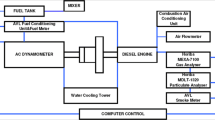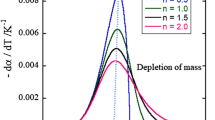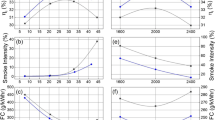Abstract
The present work describes a solution for the effective use of the hazardous particulate matter (diesel soot) from the internal combustion engines (ICEs) as a potential material emitting white light for white light emitting diodes (WLEDs). The washed soot samples are subjected to Field Emission Scanning Electron Microscopy (FESEM), High- Resolution Transmission Electron Microscopy (HR-TEM), Energy Dispersive Spectroscopy (EDS), UV–Visible, Photoluminescent (PL) Spectroscopy and quantum yield measurements. The CIE plot and Correlated Color Temperature (CCT) reveals the white fluorescence on photoexcitation. The sample on ultraviolet (UV) laser excitation, provides a visual confirmation of white light emission from the sample. The diesel soot collected from public transport buses of different years of manufacture invariably exhibit white fluorescence at an excitation of 350 nm. The sample show a quantum yield of 47.09%. The study is significant in the context of pollution and search for low-cost, rare-earth phosphor free material for white light emission and thereby turning the hazardous, futile material into a fruitful material that can be used for potential applications in photonics and electronics.








Similar content being viewed by others
References
Schubert EF, Kim JK (2005) Solid-state light sources getting smart. Science 308(5726):1274–1278
Feng XT, Zhang F, Wang YL, Zhang Y, Yang YZ, Liu XG (2015) Luminescent carbon quantum dots with high quantum yield as a single white converter for white light emitting diodes. Appl Phys Lett 107:213102
Farinola GM, Ragni R (2011) Electroluminescent materials for white organic light emitting diodes. Chem Soc Rev 40:3467–3482
Kamtekar KT, Monkman AP, Bryce MR (2010) Recent advances in white organic light-emitting materials and devices (WOLEDs). Adv Mater 22: 572 – 82
Sun C-Y, Wang X-L, Zhang X et al (2013) Efficient and tunable white-light emission of metal-organic frameworks by iridium-complex encapsulation. Nat Commun 4:2717
Motokazu Y, Yukio N, Takashi M (2002) Phosphor free high-luminous-efficiency white light-emitting diodes composed of InGaN multi-quantum well. Jpn J Appl Phys 41: L 246–L 248
Chen L-Y, Cheng W-C, Tsai C-C, Huang Y-C, Lin Y-S, Cheng W-H (2014) High-performance glass phosphor for white-light-emitting diodes via reduction of Si-Ce3+:YAG inter-diffusion. Opt Mater Express 4(1):121–128
Chen B, Zhou Q, Li J et al (2013) Red emissive CuInS2-based nanocrystals: a potential phosphor for warm white light-emitting diodes. Opt Express 2(8):10105–10110
Yang Q, Wu K, Jiang J et al (2014) Pure white-light and yellow-to-blue emission tuning in single crystals of dy (III) metal–organic frameworks. Chem Commun 50:7702–7704
Sessolo MI, Tordera D, Bolink HJ (2011) Ionic iridium complex and conjugated polymer used to solution-. a bilayer white light-emitting diode. ACS Appl Mater Interfaces 12011:329–332
Ramya AR, Varughese S, Reddy MLP (2014) Tunable white-light emission from mixed lanthanide (Eu3+, Gd3+, Tb3+) coordination polymers derived from 4-(dipyridin-2-yl)aminobenzoate. Dalton Trans 43:10940–10946
Ledemi Y, Trudel AA, Rivera VAG et al (2014) White light and multicolor emission tuning in triply doped Yb3+/Tm3+/Er3+ novel fluoro-phosphate transparent glass-ceramics. J Mater Chem C 2(25):5046–5056
Zhang Y, Xie C, Su H et al (2011) Employing heavy metal-free colloidal quantum dots in solution-processed white light-emitting diodes. Nano Lett 11:329–332
Babu SS, Aimi J, Ozawa H et al (2012) Solvent-free luminescent organic liquids. Angew Chem Int Ed Engl 51(14):3391–3395
Swapna MS, Sankararaman S (2017) Investigation of graphene oxide in diesel soot. J Mater Sci Nanotechnol 5(1): 103.1-103.6
Swapna MS, Sankararaman S (2017) Fractal analysis – a surrogate technique for material characterization. Nanosystems: Phys Chem Math 8(6):809–815
Swapna MS, Pooja VM, Anamika SA, Soumya S, Sankararaman S (2017) Synthesis and characterization of carbon nano Kajal. JOJ Mater Sci 1(4):555566.001–003
Uchida T, Ohashi O (2006) Synthesis of single-wall Carbon nanotubes from diesel soot. Jpn J Appl Phys 45:8027–8029
Swapna MS, Sankararaman S (2017) Carbon nanonecklaces with carbon nanotubes and carbon dots. Int J Mater Sci 12(3):541–548
Stanmore BR, Brilhac JF, Gilot P (2001) The oxidation of soot: a review of experiments, mechanisms and models. Carbon 39:2247–2268
Swapna MS, Beryl C, Reshma SS et al. (2017) Ultraviolet protection action of carbon nanoparticles in leaves, BioNanoSci. 7: pp 583–587
Operation manual. http://www.HORIBA.com/scientific
Hussain S, Jha P, Chouksey A et al. (2011) Spectroscopic investigation of modified single wall carbon nanotube (SWCNT). J Mod Phys 2: 538 – 543
Li HT, Kang ZH, Liu Y, Lee ST (2012) Carbon nanodots: synthesis, properties and applications. J Mater Chem 22:24230–24253
Wen Z-H, Yin X-B (2016) Excitation-independent carbon dots, from photoluminescence mechanism to single-color application. RSC Advs 6:27829–27835
Mc Camy, CS (1992) Correlated color temperature as an explicit function of chromaticity coordinates. Color Res Appl 17(2):142–144
Funding
This study was not funded by any agencies in the public, commercial, or not-for-profit sectors.
Author information
Authors and Affiliations
Corresponding author
Ethics declarations
Conflict of Interest
The authors declare that they have no conflict of interest.
Rights and permissions
About this article
Cite this article
Swapna, M.S., Sankararaman, S. From Futile to Fruitful: Diesel Soot as White Light Emitter. J Fluoresc 28, 543–549 (2018). https://doi.org/10.1007/s10895-018-2215-6
Received:
Accepted:
Published:
Issue Date:
DOI: https://doi.org/10.1007/s10895-018-2215-6




